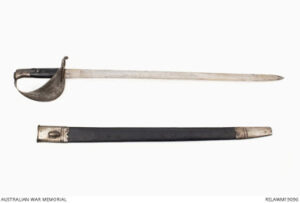

I got diverted reading about cutlasses the other day. According to the book I picked up it is not until the start of the nineteenth century that Royal Navy cutlasses were standardised, or at least records of the standard date to. In 1858 a new model of cutlass based on the 1853 cavalry sword was adopted and the blade length as standardized at 27" (right). I get the impression that most of the earlier patterns of cutlass were of this size. In 1871 weapons with a slightly shorter blade of 25½" were adopted. ’71 saw the adoption of both a new cutlass and a cutlass bayonet for the Martini-Henry rifle (below). Cutlass bayonets had been issued before, such as the 1859 model for the Enfield (above). The two ’71 pattern weapons seem to have been intended to share many common components between the bayonet and sword and the slight shortening of the blade may have been a concession to the bayonet role. In 1889 a cutlass with a blade of 28" was adopted.
What interested me about this passage was that the navy considered a blade of about 27" to be ideal for a cutlass. Most British army swords of this period are 32" or more in length. Cavalry swords tend to be longer and in the 33 to 36" range. I have a 1898 Officer’s sword with a 32" blade. It is a very nice weapon but I cannot handle it without feeling it would be handier and more agile with a few inches removed.
27-28" is also the “Perfect Length” for a sword that I pondered on in a previous post.
